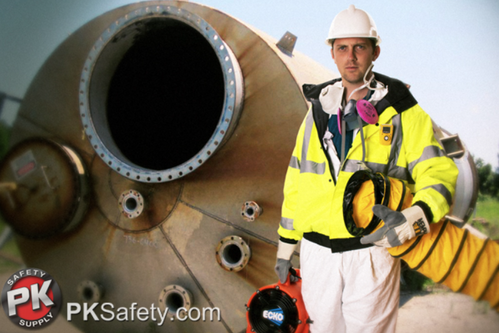Starting a New Confined Space Entry Program
What happens when your small business grows, and you find yourself having to contend for the first time with confined space issues? There is quite a bit to do, and every aspect has a specific reason for being. Here is a basic primer for working in confined spaces for those who have not had these important responsibilities before.
First, conduct an assessment of the on-site hazards. Describe the different roles and responsibilities of each of the parties involved in servicing these confined space areas from the employers to the workers, the attendants to the confined space entrants. You'll need to carefully check to make sure you are aware of the roles required by OSHA for each team member.
Next make notes on how workers can identify confined spaces. Take some time to detail those hazards - what dangers may be present when work starts, and what problems may develop as work progresses. A plan must be developed and spelled out carefully that explains how these problems can be rectified or controlled.
The workers themselves also need to be trained with the materials you have developed. The training for confined space work, entry, and rescue will be ongoing for the life of your work site. This training will need to include emergency planning that includes training and equipment that is ready and accessible when situations occur.
This training program must be reviewed at least annually, and contain a section that allows for identifying weaknesses and making changes when necessary. All aspects of the program must be documented and any changes recorded, and an entry permit system must be developed that will allow workers, entrants, supervisors and all other potentially affected personnel to be aware of the scope of the confined space entry project.
Once you've got that under control, you need to work out a system for entry. A permit should be used that will spell out the length of time a particular space will be occupied, the names of the workers who will carry out the tasks, as well as the names of the attendants and supervisors for the project. The permit must explain what particular work is to be done, what hazards may be encountered both inside and outside the space, and the date and time of the atmospheric testing.
In addition to the results from the air monitoring, the permit would ideally also include the results from the last calibration performed. It will also cover the hazard control measures used including fans and forced air ventilation as well as a list of any other protective equipment needed in the confined space. Will emergency Self-Contained Breathing Apparatus (SCBA) be standing by in case of an emergency? Will a tripod and winch be used for non-entry extraction if a worker becomes incapacitated? These are the types of forward thinking that will be required as part of any successful confined space entry program.
Communication with confined space entrants is also vitally important. Whether that is an attendant constantly talking with the entrant during the work, or a full Confined Space Communications system.
Finally, the form must be signed by the supervisor and the person who did the testing, certifying the space has been properly evaluated, prepared, and is a safe work environment.
Recent Posts
-
Why Hi-Vis Winter Work Gear is Essential for Safety During the Cold Months | PK Safety
When temperatures drop and daylight hours shrink, outdoor workers face additional hazards that incre …Oct 31st 2024 -
Self Braking Descender: Advanced Rope Control for Fall Protection | PK Safety
For professionals working at heights, controlled descent is critical. Whether you’re a window cle …Oct 30th 2024 -
Hand and Eye PPE Machinists Rely On | PK Safety
Machining environments are inherently dangerous, with workers often surrounded by heavy machinery …Oct 27th 2024





